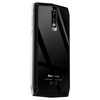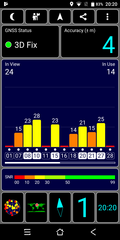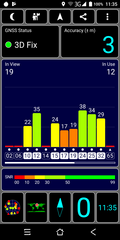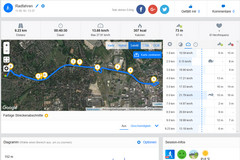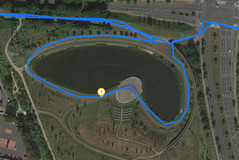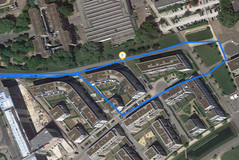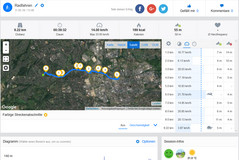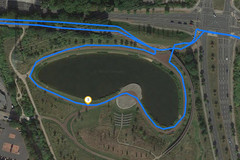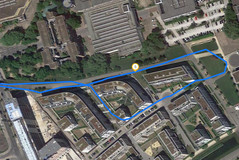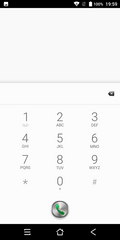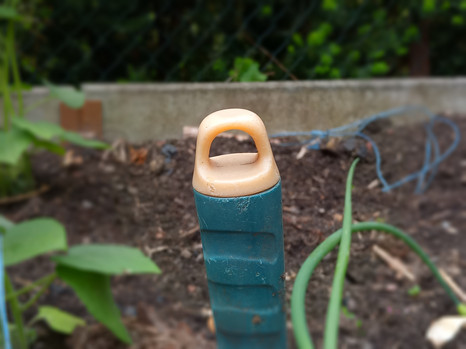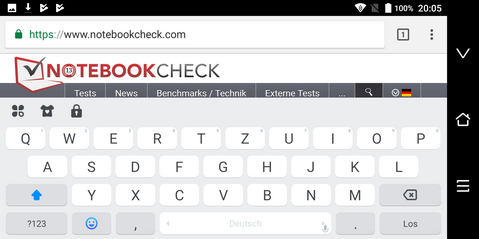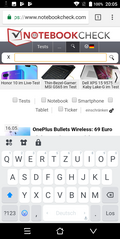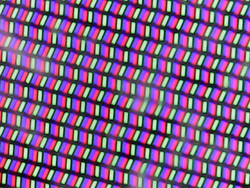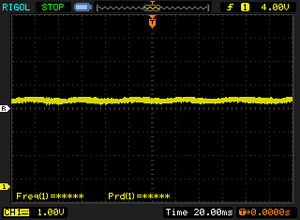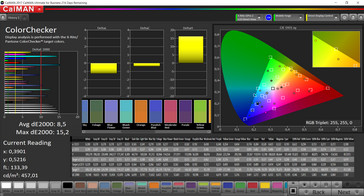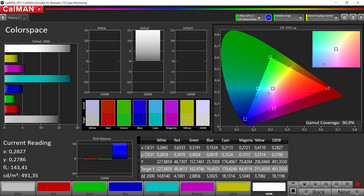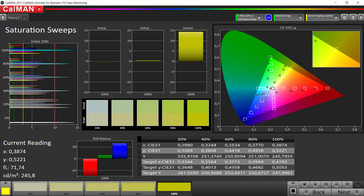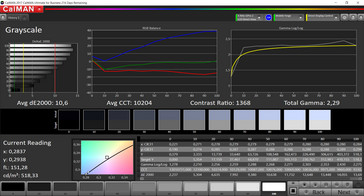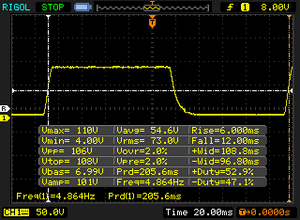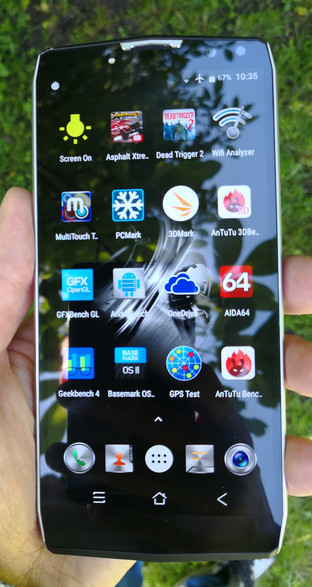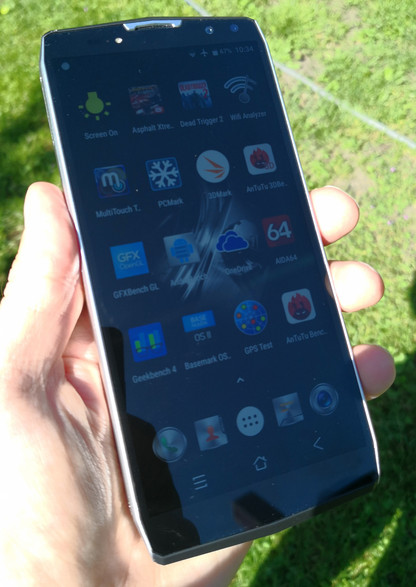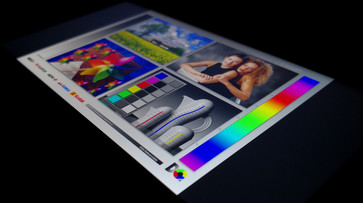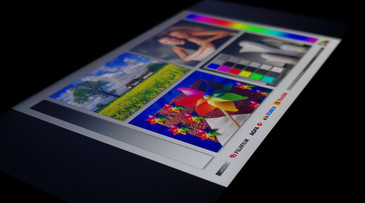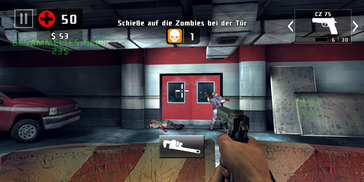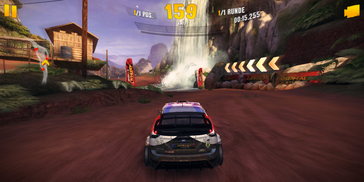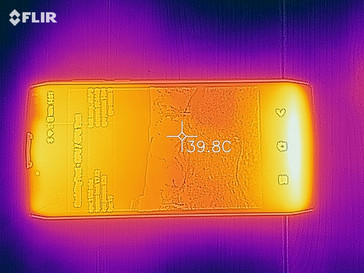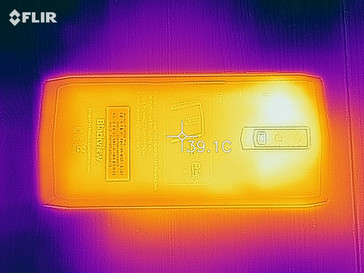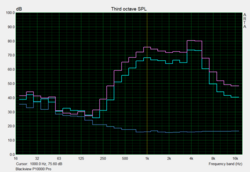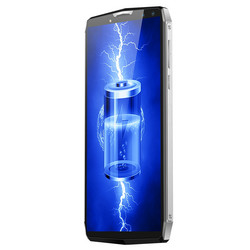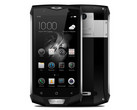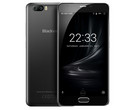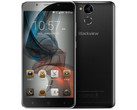Blackview P10000 Pro Smartphone Review
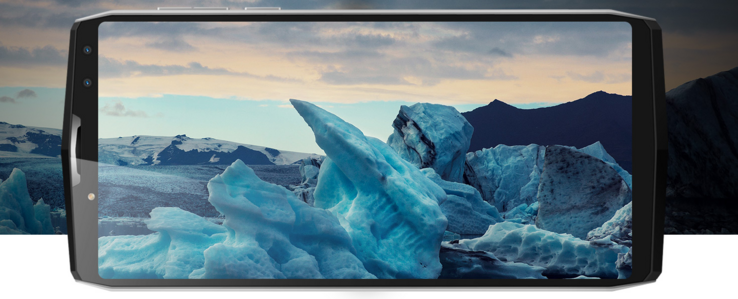
The P10000 Pro smartphone model from the Chinese manufacturer Blackview is geared for endurance. With its 11,000-mAh battery, the dual-SIM smartphone is supposed to achieve a battery life of one week. Despite the long endurance, the Blackview P10000 Pro has a 6-inch 2:1 display with quite a high resolution of 2160x1080 pixels.
The mid-range MediaTek Helio P23 SoC ensures the performance and is accompanied by 4 GB of RAM and 64 GB internal storage from Samsung. In addition, the Chinese manufacturer has equipped it with a dual camera system in the back as well as in the front. A fingerprint sensor and Quick-Charge technology are also included.
Since Blackview is not selling its smartphones directly on the German market, the P10000 Pro can only be purchased through import companies. While (in terms of the price) the current competitors of the roughly 170 Euro (~$199) dual-SIM smartphone include the Ulefone Power 3, the Xiaomi Redmi 5 Plus, the Sony Xperia L2, the Huawei P smart, the HTC Desire 12, and the Samsung Galaxy J5 (2017) Duos, all these smartphones have a significantly smaller battery. We therefore consider the visually and technically very similar Oukitel K10 its main competitor.
Case
The huge battery size comes at the expense of the mobility. At a thickness of almost 1.5 cm (~0.6 in), the Blackview P10000 Pro is very fat for current circumstances. At 73%, the P10000 Pro also does not have a high display-to-surface ratio. The bezels around the 6-inch display are quite wide on the sides as well as the top and bottom, and the Blackview smartphone is very unwieldy overall. The enormous weight of almost 300 grams (~10.6 oz) also does not contribute to better handling.
The case of the affordable, mid-range smartphone is primarily made of plastic and shows good workmanship. You have the choice between one version with a smooth back (probably made of plastic) in silver and gray colors and a version with a back made from real leather. Our test unit has a smooth back that is very sensitive to fingerprints.
The frame is slightly edgy, and the stability and stiffness are very good due to its dimensions. The keys on the right side for the volume and on/off can easily be reached and have a comfortable pressure point.
Equipment
As usual in this price-range, the P10000 Pro has eMMC storage with a capacity of 64 GB. About 52 GB of that are still available to the user in the state of delivery. To expand the built-in data storage, you can also use an SD card slot, which supports microSD cards of size unknown (to us). Our 64 GB reference card was recognized and could be integrated into the internal storage.
The USB port is Type-C, based on a USB-2.0 connector to charge the device. External storage media or input devices are not recognized via USB OTG.
In addition to Wi-Fi Direct, the mid-range device includes an FM radio, a notification LED, Wi-Fi calling, and a fingerprint reader. The wireless transfer of display content to an external monitor via Miracast is also supported and worked very well with a Sony Android TV in our test.
Software - Android Oreo in the near future
The operating system installed on the P10000 Pro is based on Android 7.1 Nougat. According to the manufacturer, the most current version 8.1 of Google's Android platform is supposed to become available soon. At the time of the test, the system was on the security patch level of April 2018.
There is no unnecessary preinstalled bloatware. The manufacturer's own user interface is strongly reminiscent of Google's stock Android and is only minimally adapted. However, you do not need to go without special software functions such as gesture navigation in the Blackview smartphone.
Even though we selected German as the system language, English was still used in some places.
Communication and GPS
While traveling, the P10000 Pro uses LTE Cat. 6 (300 Mbit/s downstream, 50 Mbit/s upstream) in the frequencies 800, 900, 1800, 2100, and 2600 MHz for connecting to the mobile Internet. Thus LTE band 20, which is important in rural areas in Germany, is also supported. The dual-SIM smartphone has two slots for nanoSIM cards. With both slots, you can connect to the mobile Internet at LTE speeds.
The integrated WLAN module of the Blackview smartphone handles the IEEE-802.11 a/b/g/n standards and transmits in the 2.4-GHz and the 5-GHz frequencies. The range, as well as the signal stability, is okay. While the Wi-Fi transfer speed between the Blackview smartphone and our Linksys EA 8500 reference router are on a rather low level at slightly above 100 Mbit/s, other devices of this price range neither do better nor worse in our Wi-Fi test either.
The Blackview P10000 Pro determines its location using GPS and the GLONASS global navigation satellite system. We tested the connection performance of the GPS module to the satellites via the "GPS-Test" app. Outdoors, the position was located quickly with an accuracy of 3 meters (~10 ft). The accuracy indoors dropped marginally to 4 meters (~13 ft), and the connection to the satellite took slightly longer.
In addition, we tested the mid-range smartphone on an almost 9.5 km (~5.9 miles) test tour, comparing it with the results of the Garmin Edge 500 professional navigation device. Overall, the performance of the P10000 Pro was very good for its price range. Over the whole route, the two devices showed only a difference of 10 meters (~33 ft). With this, the GPS performance of our test unit is at a good level.
Telephone Functions and Voice Quality
Using the Vodafone net, the voice quality of the P10000 Pro is good on both sides of the conversation. The voice from the earpiece is understandable and the maximum volume is sufficient. In loud surroundings, our conversation partner was hard to understand in some cases. The voice reproduction is natural and the quality of the built-in microphone was described as very understandable by our conversation partner.
The Telephone app offers all the features known from stock Android such as Favorites, the list of calls, and an integrated phone book. In addition, you can open a number pad for manual entry of phone numbers.
Cameras - Dual cameras without much benefit
The Chinese manufacturer does not offer much information on the built-in camera modules. There is a dual camera unit in the back, consisting of one 16-MP camera (4608x3456 pixels) with auto-focus and one 0.3-MP camera. Due to the aperture of f/2.0, i.e., the ratio of the focal distance to the diameter, a relatively large amount of light reaches the Sony IMX298 image sensor, which is the same as that found in the Huawei Mate 8.
While the camera in the back does fairly well during daylight, scoring with a good sharpness and detail, the photos tend to be overexposed. With good illumination, close-up photos also look decent. However, the Bokeh effect created with the additional camera is of little use.
With less light, the image noise increases, so that the images show a noticeable graininess and look quite dark and the colors dull. In darker subjects, the details become completely lost with the 16-MP camera. Videos can be recorded in a maximum of 1080p at a frame rate of 30 FPS. If you use the camera in front, the video resolution drops to 720p at 30 FPS.
With an aperture of f/2.8, the lens in front is significantly less light sensitive and only has a resolution of 13 MP. Like in the main camera, the photo quality drops considerably with decreasing light conditions and the Bokeh effect is useless. Overall, the photos of the Sony IMX135 sensor are sufficient for selfie snapshots.
Accessories and Warranty
Besides the smartphone itself, the box of our test unit contained a silicone case, a user manual, earphones, a USB cable and a modular 10-W charger (5 V, 2 A), and Blackview also added 2 adapters for USB Type-C to microUSB and USB Type-A to USB-C.
The warranty duration is 12 months. Please see our Guarantees, Return policies and Warranties FAQ for country-specific information.
Input Devices and Operation - Blackview smartphone with face recognition
In its mid-range smartphone, Blackview uses on-screen navigation in the lower third of the display. The capacitive touchscreen recognizes up to five touch-points simultaneously and has a glass surface with good sliding characteristics. The multi-touchscreen responds accurately to input up to the edge areas of the display.
The Chinese manufacturer has preinstalled the Kika keyboard for text input.
You can use biometric identification via fingerprints to unlock the P10000 Pro. However, the active fingerprint sensor on the right side of the case is only usable to a limited extent, since subjectively half of the unlocking attempts via fingerprint fail. In addition, the Blackview smartphone offers identification via face recognition, which works quite well in good light conditions and during the day makes up for the lack of accuracy in the fingerprint sensor.
Display - P10000 Pro with 2:1 form factor
The IPS-LC display from Sharp measures 15.3 cm (6 in) in the diagonal, having a 18:9 form factor and a resolution of 2160x1080 pixels. This results in a good pixel density of 400 PPI. Text content appears sharp even in small lettering, and pixel structures are not visible from a normal viewing distance.
While the LED backlight achieves a maximum brightness of up to 532 cd/m², this is only sufficient for an average brightness of 513 cd/m², since the brightness distribution is slightly uneven at 89%. The realistic APL-50 (Average Picture Level) test with evenly distributed light and dark areas results in a similar maximum brightness of 516 cd/m².
| |||||||||||||||||||||||||
Brightness Distribution: 89 %
Center on Battery: 513 cd/m²
Contrast: 1386:1 (Black: 0.37 cd/m²)
ΔE ColorChecker Calman: 8.5 | ∀{0.5-29.43 Ø4.79}
ΔE Greyscale Calman: 10.6 | ∀{0.09-98 Ø5}
Gamma: 2.29
CCT: 10204 K
| Blackview P10000 Pro IPS, 2160x1080, 6" | Xiaomi Redmi 5 Plus IPS, 2160x1080, 6" | HTC Desire 12 IPS, 1440x720, 5.5" | Sony Xperia L2 IPS, 1280x720, 5.5" | Samsung Galaxy J5 (2017) Duos Super AMOLED, 1280x720, 5.2" | Huawei P smart IPS, 2160x1080, 5.7" | Ulefone Power 3 IPS, 2160x1080, 6" | Oukitel K10 IPS, 2160x1080, 6" | Sony Xperia XZ2 IPS, 2160x1080, 5.7" | |
|---|---|---|---|---|---|---|---|---|---|
| Screen | 18% | 28% | -3% | 28% | 11% | 19% | -13% | 34% | |
| Brightness middle (cd/m²) | 513 | 620 21% | 502 -2% | 393 -23% | 448 -13% | 573 12% | 494 -4% | 561 9% | 630 23% |
| Brightness (cd/m²) | 507 | 612 21% | 499 -2% | 400 -21% | 451 -11% | 568 12% | 485 -4% | 541 7% | 632 25% |
| Brightness Distribution (%) | 89 | 96 8% | 84 -6% | 93 4% | 91 2% | 89 0% | 87 -2% | 92 3% | 96 8% |
| Black Level * (cd/m²) | 0.37 | 0.57 -54% | 0.2 46% | 0.55 -49% | 0.63 -70% | 0.33 11% | 0.58 -57% | 0.44 -19% | |
| Contrast (:1) | 1386 | 1088 -22% | 2510 81% | 715 -48% | 910 -34% | 1497 8% | 967 -30% | 1432 3% | |
| Colorchecker dE 2000 * | 8.5 | 3.46 59% | 5.4 36% | 6.1 28% | 2.7 68% | 4.2 51% | 5.1 40% | 10 -18% | 1.5 82% |
| Colorchecker dE 2000 max. * | 15.2 | 7.88 48% | 10.8 29% | 10.4 32% | 9.8 36% | 6.4 58% | 9.9 35% | 16.7 -10% | 4.3 72% |
| Greyscale dE 2000 * | 10.6 | 3.9 63% | 6.2 42% | 4.8 55% | 1.6 85% | 4.6 57% | 3.5 67% | 11.1 -5% | 2.1 80% |
| Gamma | 2.29 96% | 2.073 106% | 2.07 106% | 2.01 109% | 2.06 107% | 2.24 98% | 2.16 102% | 1.8 122% | 2.17 101% |
| CCT | 10204 64% | 7230 90% | 7660 85% | 7432 87% | 6557 99% | 7157 91% | 7253 90% | 9689 67% | 6513 100% |
* ... smaller is better
Screen Flickering / PWM (Pulse-Width Modulation)
| Screen flickering / PWM not detected | |||
In comparison: 53 % of all tested devices do not use PWM to dim the display. If PWM was detected, an average of 8167 (minimum: 5 - maximum: 343500) Hz was measured. | |||
The combination of display brightness and the black value of 0.37cd/m² results in a very good contrast ratio of about 1:1400. Our APL-50 measurement finds a similar high contrast (1:1396), since the black value in evenly distributed light and dark areas remains constant.
The display analysis with a photo spectrometer and the CalMAN software shows deviations in the color (8.5) and Grayscale (10.6) display that are quite high even for this price range. At 10,000 Kelvin, the color temperature is too cool, actually resulting in a visible blue tint.
Those who do not like the standard settings of the display can readjust the contrast and color intensity.
Display Response Times
| ↔ Response Time Black to White | ||
|---|---|---|
| ms ... rise ↗ and fall ↘ combined | ↗ 6 ms rise | |
| ↘ 12 ms fall | ||
| The screen shows very fast response rates in our tests and should be very well suited for fast-paced gaming. In comparison, all tested devices range from 0.1 (minimum) to 240 (maximum) ms. » 0 % of all devices are better. This means that the measured response time is better than the average of all tested devices (20.3 ms). | ||
| ↔ Response Time 50% Grey to 80% Grey | ||
| ms ... rise ↗ and fall ↘ combined | ↗ 19.2 ms rise | |
| ↘ 21.6 ms fall | ||
| The screen shows very fast response rates in our tests and should be very well suited for fast-paced gaming. In comparison, all tested devices range from 0.165 (minimum) to 636 (maximum) ms. » 0 % of all devices are better. This means that the measured response time is better than the average of all tested devices (31.7 ms). | ||
The Liquid Crystal Display of the Blackview P10000 Pro offers sufficient brightness to recognize the display contents even on sunny days. However, the reflective screen cannot really be read in direct sunlight. As typical for IPS panels, the stability of viewing angles is very good, and you only notice a slight reduction in the brightness from extreme viewing angles.
Performance
The MediaTek MT6763 Helio P23 is a mid-range SoC that was introduced in 2017 and integrates 8 ARM Cortex-A53 cores in two clusters. The energy-efficient cluster has a clock speed of up to 1.65 GHz, while the four cores in the performance cluster run at up to 2.3 GHz. Thanks to the big.LITTLE architecture, the eight cores can also be used simultaneously. The integrated graphics card is an ARM Mali G71 MP2.
While in everyday operation, the performance of the MT6763 in the Blackview P10000 Pro ensures smooth navigation in the Home screen, as soon as there is some demand on the processor, some stutters and delays opening apps occur. We see the system hanging sometimes during multitasking. In many benchmarks, the Blackview smartphone delivers good performance that is in parts even slightly above that of the competitors.
| Lightmark - 1920x1080 1080p (sort by value) | |
| Ulefone Power 3 | |
| Oukitel K10 | |
| Average Mediatek Helio P23 MT6763T (4.99 - 5.25, n=2) | |
| Basemark ES 3.1 / Metal - offscreen Overall Score (sort by value) | |
| Ulefone Power 3 | |
| Oukitel K10 | |
| Average Mediatek Helio P23 MT6763T (242 - 242, n=2) | |
| Average of class Smartphone (205 - 7731, n=36, last 2 years) | |
Subjectively, the browser speed is only average for a smartphone of the mid-range. The page contents take a bit long until they are loaded, and scrolling does not always appear smooth. The Blackview P10000 Pro is only in the middle of the comparison field in the benchmarks as well.
| JetStream 1.1 - Total Score | |
| Sony Xperia XZ2 (Chrome 65) | |
| Huawei P smart (Chrome 64) | |
| Samsung Galaxy J5 (2017) Duos (Samsung Browser 5.4) | |
| Xiaomi Redmi 5 Plus (Chrome 66) | |
| Ulefone Power 3 (Standardbrowser 7.1.1) | |
| Average Mediatek Helio P23 MT6763T (17.9 - 25.9, n=7) | |
| Oukitel K10 (Standard Browser 7.1.1) | |
| Sony Xperia L2 | |
| Blackview P10000 Pro (Chrome 66) | |
| HTC Desire 12 (Chrome 66.0.3359.158) | |
| Octane V2 - Total Score | |
| Average of class Smartphone (2228 - 121337, n=199, last 2 years) | |
| Sony Xperia XZ2 (Chrome 65) | |
| Samsung Galaxy J5 (2017) Duos (Samsung Browser 5.4) | |
| Huawei P smart (Chrome 64) | |
| Xiaomi Redmi 5 Plus (Chrome 66) | |
| Average Mediatek Helio P23 MT6763T (3051 - 4987, n=8) | |
| Blackview P10000 Pro (Chrome 66) | |
| Ulefone Power 3 (Standardbrowser 7.1.1) | |
| Oukitel K10 (Standard Browser 7.1.1) | |
| Sony Xperia L2 | |
| HTC Desire 12 (Chrome 66.0.3359.158) | |
| Mozilla Kraken 1.1 - Total | |
| Ulefone Power 3 (Standardbrowser 7.1.1) | |
| Oukitel K10 (Standard Browser 7.1.1) | |
| HTC Desire 12 (Chrome 66.0.3359.158) | |
| Average Mediatek Helio P23 MT6763T (11352 - 23714, n=8) | |
| Blackview P10000 Pro (Chrome 66) | |
| Sony Xperia L2 | |
| Xiaomi Redmi 5 Plus (Chrome 66) | |
| Huawei P smart (Chrome 64) | |
| Samsung Galaxy J5 (2017) Duos (Samsung Browser 5.4) | |
| Sony Xperia XZ2 (Chrome 65) | |
| Average of class Smartphone (257 - 28190, n=154, last 2 years) | |
* ... smaller is better
Compared to the competition, the access rates of the internal eMMC storage are only average. You can see the performance deficits in the eMMC storage in the P10000 Pro if you look at the results of the Oukitel K10.
We evaluated the speed of the integrated microSD card slot using our Toshiba Exceria Pro M501 reference storage card (max. read: 270 MB/s, write: 150 MB/s). The read and write rates are on the level of other mid-range smartphones.
| Blackview P10000 Pro | Xiaomi Redmi 5 Plus | HTC Desire 12 | Sony Xperia L2 | Samsung Galaxy J5 (2017) Duos | Huawei P smart | Ulefone Power 3 | Oukitel K10 | Sony Xperia XZ2 | Average 64 GB eMMC Flash | Average of class Smartphone | |
|---|---|---|---|---|---|---|---|---|---|---|---|
| AndroBench 3-5 | 28% | -24% | -39% | -31% | 28% | 41% | 38% | 86% | 44% | 1324% | |
| Sequential Read 256KB (MB/s) | 284.3 | 270 -5% | 211.4 -26% | 70.6 -75% | 204.4 -28% | 269.4 -5% | 294.6 4% | 291.5 3% | 679 139% | 277 ? -3% | 2207 ? 676% |
| Sequential Write 256KB (MB/s) | 112.3 | 194.5 73% | 103.8 -8% | 52.8 -53% | 52 -54% | 121.1 8% | 214.9 91% | 213.3 90% | 198.7 77% | 178.4 ? 59% | 1822 ? 1522% |
| Random Read 4KB (MB/s) | 29.98 | 79.5 165% | 16.69 -44% | 22.32 -26% | 24.07 -20% | 66.1 120% | 61.4 105% | 52.2 74% | 149.4 398% | 60.7 ? 102% | 292 ? 874% |
| Random Write 4KB (MB/s) | 14.6 | 7.1 -51% | 7.54 -48% | 8.99 -38% | 9.9 -32% | 21.3 46% | 21.25 46% | 22.88 57% | 17 16% | 33.8 ? 132% | 339 ? 2222% |
| Sequential Read 256KB SDCard (MB/s) | 80.9 ? | 84.4 4% | 81.8 ? 1% | 70.6 ? -13% | 72.2 ? -11% | 82.3 ? 2% | 81.8 ? 1% | 82.2 ? 2% | 34.25 ? -58% | 77.4 ? -4% | |
| Sequential Write 256KB SDCard (MB/s) | 73.3 ? | 59.5 -19% | 61.1 ? -17% | 52.8 ? -28% | 44.21 ? -40% | 72.4 ? -1% | 71.9 ? -2% | 74.7 ? 2% | 30.12 ? -59% | 58.3 ? -20% |
Games
The integrated graphics card is an ARM Mali G71 (MP2) with a clock speed of 700 MHz. The MP2 variant of the Mali G71 integrates two of the 32 possible graphics cores and supports OpenGL ES 3.2, Vulkan 1.0, OpenCL 2.0, DirectX 11, and RenderScript.
More demanding 3D games from the Android Play Store cannot be played smoothly. When testing the "Asphalt Xtreme" game we could notice drops in the frame rates and long load times.
In our games test, the G71 GPU in the Oukitel K10 achieved an average frame rate of 23 FPS in the "Asphalt 8" race game.
The control via touchscreen as well the position sensor reacts without any problems in games.
Emissions - The Blackview speaker is dissappointing
Temperature
The surface temperatures of the Blackview P10000 Pro remain within an uncritical range. However, under constant full load, the mid-range smartphone warms up to above 43 °C (109 °F). On the back surface, we measure just below 38 °C (100 °F).
(±) The maximum temperature on the upper side is 43.2 °C / 110 F, compared to the average of 35.2 °C / 95 F, ranging from 21.9 to 247 °C for the class Smartphone.
(+) The bottom heats up to a maximum of 37.7 °C / 100 F, compared to the average of 34 °C / 93 F
(±) In idle usage, the average temperature for the upper side is 36 °C / 97 F, compared to the device average of 32.9 °C / 91 F.
Speaker
The mono speaker is on the bottom of the case. While the sound quality is not convincing, considering the price level, the sound is okay.
As expected, the sound is dominated by mid and high frequencies that are not reproduced in a very linear fashion. The Pink-Noise diagram also shows that the bass is not audible. In our test, the speaker reaches a maximum volume of up to 87 dB(A).
There is no 3.5-mm port for audio output. Strangely, output via USB Type-C headphones is not supported by the USB Type-C connection, but only headphones with a 3.5-mm jack are recognized using an adapter.
Blackview P10000 Pro audio analysis
(+) | speakers can play relatively loud (86.5 dB)
Bass 100 - 315 Hz
(-) | nearly no bass - on average 31% lower than median
(±) | linearity of bass is average (9.2% delta to prev. frequency)
Mids 400 - 2000 Hz
(±) | higher mids - on average 6.3% higher than median
(±) | linearity of mids is average (8% delta to prev. frequency)
Highs 2 - 16 kHz
(±) | higher highs - on average 9.6% higher than median
(±) | linearity of highs is average (11.2% delta to prev. frequency)
Overall 100 - 16.000 Hz
(±) | linearity of overall sound is average (29.6% difference to median)
Compared to same class
» 77% of all tested devices in this class were better, 4% similar, 20% worse
» The best had a delta of 12%, average was 35%, worst was 134%
Compared to all devices tested
» 87% of all tested devices were better, 3% similar, 10% worse
» The best had a delta of 4%, average was 24%, worst was 134%
Oukitel K10 audio analysis
(+) | speakers can play relatively loud (87.6 dB)
Bass 100 - 315 Hz
(-) | nearly no bass - on average 34.9% lower than median
(±) | linearity of bass is average (7.7% delta to prev. frequency)
Mids 400 - 2000 Hz
(±) | reduced mids - on average 5.3% lower than median
(+) | mids are linear (6.4% delta to prev. frequency)
Highs 2 - 16 kHz
(±) | higher highs - on average 6.1% higher than median
(+) | highs are linear (6.4% delta to prev. frequency)
Overall 100 - 16.000 Hz
(±) | linearity of overall sound is average (25.3% difference to median)
Compared to same class
» 62% of all tested devices in this class were better, 7% similar, 31% worse
» The best had a delta of 12%, average was 35%, worst was 134%
Compared to all devices tested
» 77% of all tested devices were better, 5% similar, 18% worse
» The best had a delta of 4%, average was 24%, worst was 134%
Battery Life
Power Consumption
The power consumption is comparable with that of the comparison devices we used in this test. Compared to the Oukitel K10, the P10000 Pro uses slightly less power on average.
| Off / Standby | |
| Idle | |
| Load |
|
Key:
min: | |
| Blackview P10000 Pro 11000 mAh | Xiaomi Redmi 5 Plus 4000 mAh | HTC Desire 12 2730 mAh | Sony Xperia L2 3300 mAh | Samsung Galaxy J5 (2017) Duos 3000 mAh | Huawei P smart 3000 mAh | Ulefone Power 3 6080 mAh | Oukitel K10 11000 mAh | Sony Xperia XZ2 3180 mAh | Average Mediatek Helio P23 MT6763T | Average of class Smartphone | |
|---|---|---|---|---|---|---|---|---|---|---|---|
| Power Consumption | -26% | -8% | 31% | 43% | 1% | 15% | -6% | -20% | -7% | -32% | |
| Idle Minimum * (Watt) | 0.63 | 0.7 -11% | 1.13 -79% | 0.5 21% | 0.52 17% | 0.62 2% | 0.79 -25% | 0.89 -41% | 0.72 -14% | 0.873 ? -39% | 0.856 ? -36% |
| Idle Average * (Watt) | 2.2 | 2.8 -27% | 2.03 8% | 1.12 49% | 1.17 47% | 1.76 20% | 1.82 17% | 2.48 -13% | 2.21 -0% | 2.08 ? 5% | 1.437 ? 35% |
| Idle Maximum * (Watt) | 2.3 | 3.4 -48% | 2.05 11% | 1.25 46% | 1.24 46% | 1.87 19% | 1.87 19% | 2.52 -10% | 2.22 3% | 2.18 ? 5% | 1.612 ? 30% |
| Load Average * (Watt) | 3.57 | 4.2 -18% | 3.68 -3% | 2.92 18% | 1.66 54% | 4.47 -25% | 2.7 24% | 3.13 12% | 4.6 -29% | 3.88 ? -9% | 7.1 ? -99% |
| Load Maximum * (Watt) | 5.82 | 7.2 -24% | 4.52 22% | 4.66 20% | 2.94 49% | 6.39 -10% | 3.62 38% | 4.5 23% | 9.34 -60% | 5.58 ? 4% | 11.2 ? -92% |
* ... smaller is better
Battery Life
The highlight of the Blackview P10000 Pro is the battery life. The 11,000-mAh battery in the mid-range smartphone puts even comparison devices that have a very good battery life to shame. In our WLAN test with an adjusted display brightness of 150 cd/m², the P10000 Pro clearly surpasses the Oukitel K10 by almost 10 hours.
Due to the Quick-Charge technology, the time it takes to fully charge it remains within limits and the battery is fully recharged within about 3 hours.
| Blackview P10000 Pro 11000 mAh | Xiaomi Redmi 5 Plus 4000 mAh | HTC Desire 12 2730 mAh | Sony Xperia L2 3300 mAh | Samsung Galaxy J5 (2017) Duos 3000 mAh | Huawei P smart 3000 mAh | Ulefone Power 3 6080 mAh | Oukitel K10 11000 mAh | Sony Xperia XZ2 3180 mAh | |
|---|---|---|---|---|---|---|---|---|---|
| Battery runtime | |||||||||
| WiFi v1.3 (h) | 35.8 | 8.3 -77% | 7.3 -80% | 11.5 -68% | 12.3 -66% | 9.4 -74% | 22.9 -36% | 27.2 -24% | 11.3 -68% |
Pros
Cons
Verdict - Blackview smartphone with the battery life of a feature phone
The Blackview P10000 Pro keeps its promise of an extremely long battery life. Due to the 11,000-mAh battery, the almost 300-gram (~10.6 oz) smartphone is quite unwieldy. In combination with a case thickness of almost 1.5 cm (~0.6 in), this might be a disqualifier for most buyers.
Aside from that, the Blackview P10000 Pro scores with a high-contrast IPS panel, accurate GPS, a decent camera, and sufficient performance. However, the speaker is anything but good, and the system performance could have been a bit smoother.
Compared to our designated main competitor, the Oukitel K10, the P10000 Pro is superior in almost all areas (GPS, WLAN, display, performance). In addition, it lasts almost 500 minutes longer in the WLAN test with its 11,000-mAh battery.
Considering the dimensions of the Blackview P10000 Pro in combination with the weight of a 7-inch tablet, it is difficult to offer a recommendation. However, for those who are depending on a very, very long battery life, the Blackview smartphone might be the ideal companion.
Blackview P10000 Pro
- 05/26/2018 v6 (old)
Marcus Herbrich







